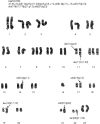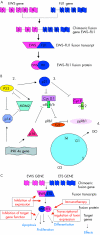Ewing's sarcoma: diagnostic, prognostic, and therapeutic implications of molecular abnormalities
- PMID: 12560386
- PMCID: PMC1769883
- DOI: 10.1136/jcp.56.2.96
Ewing's sarcoma: diagnostic, prognostic, and therapeutic implications of molecular abnormalities
Abstract
The identification of the non-random chromosome rearrangements between the EWS gene on chromosome 22q12 and members of the ETS gene family in Ewing's sarcoma, peripheral primitive neuroectodermal tumour, Askin tumour, and neuroepithelioma has been a key advance in understanding their common histogenesis and defining the Ewing's sarcoma family of tumours (ESFT). In addition to improvements in diagnosis and potentially the stratification of patients for risk, biological investigations of these gene fusions may define targets for much needed therapeutic strategies to eliminate minimal residual disease or metastatic disease. Insight into their relation with other oncogenic events in ESFT will advance risk group analysis and ultimately may improve clinical management and survival for patients with this disease.
Figures


References
-
- Huvos AG. Ewing’s sarcoma. In: Huvos AG, ed. Bone tumors: diagnosis, treatment and prognosis, 2nd ed. Philadelphia PA: Sanders, 1991:523–52.
-
- Hutter RVP, Francis KC, Foote FW. Ewing’s sarcoma in siblings. Am J Surg 1964;107:598. - PubMed
-
- Zamora P, Garcia de Paredes ML, Gonzalez Baron M, et al. Ewing’s tumor in brothers. An unusual observation. Am J Clin Oncol 1986;9:358–60. - PubMed
-
- Joyce MJ, Harmon DC, Mankin HJ, et al. Ewing’s sarcoma in female siblings: a clinical report and review of the literature. Cancer 1984;53:1959–62. - PubMed
Publication types
MeSH terms
LinkOut - more resources
Full Text Sources
Other Literature Sources
Medical
